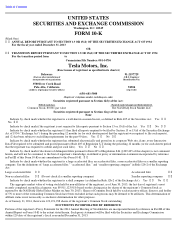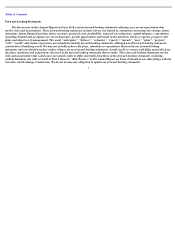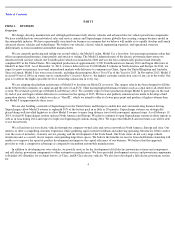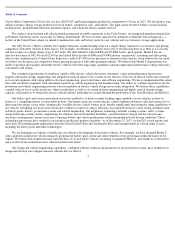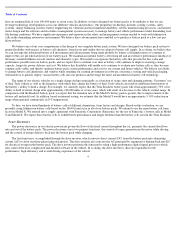Tesla 2014 Annual Report Download - page 11
Download and view the complete annual report
Please find page 11 of the 2014 Tesla annual report below. You can navigate through the pages in the report by either clicking on the pages listed below, or by using the keyword search tool below to find specific information within the annual report.
Table of Contents
The second function, charging the battery pack, is accomplished by the charger, which converts alternating current (usually from a wall
outlet or other electricity source) into direct current that can be accepted by the battery. Tesla vehicles can recharge on a variety of AC electrical
outlets, from a common outlet of 15 amps and 120 volts up to a high power circuit of 80 amps and 240 volts, which provides faster recharging.
The most common home charging system uses a 14-50 type outlet at 40 amps and 240 volts to recharge at an EPA equivalent rate of 29 miles
per hour of charge time.
In the United States, Model S vehicles are delivered with an SAE 1772 industry standard adapter that enables public AC charging at
thousands of stations. The European version of Model S has an industry standard vehicle inlet connector that is also compatible with public
charge stations around Europe. Vehicles in both the United States and Europe also come with the Tesla Mobile Connector which enables
charging from a variety of different outlets for customers who want a portable solution with maximum flexibility. For the fastest possible
charging, we offer a high-voltage, direct current option for Model S that enables the vehicle to charge from Tesla’s Supercharger network.
Superchargers are able to replenish 50% of the battery pack in as little as 20 minutes of charge time. This flexibility in charging provides
customers with additional mobility, while also allowing them to conveniently charge the vehicle overnight at home.
Vehicle Control and Infotainment Software
The performance and safety systems of our vehicles and their battery packs require sophisticated control software. There are numerous
processors in our vehicles to control these functions, and we write custom firmware for many of these processors. The flow of electricity
between the battery pack and the motor must be tightly controlled in order to deliver the performance and behavior expected in the vehicle. For
example, software algorithms enable the vehicle to mimic the “creep” feeling which drivers expect from an internal combustion engine vehicle
without having to apply pressure on the accelerator. Similar algorithms control traction, vehicle stability and the sustained acceleration and
regenerative braking of the vehicle. Software also is used extensively to monitor the charge state of each of the cells of the battery pack and to
manage all of its safety systems. Drivers use the information and control systems in our vehicles to optimize performance, customize vehicle
behavior, manage charging modes and times and control all infotainment functions. We develop almost all of this software, including most of the
user interfaces, internally.
Vehicle Design and Engineering
In addition to the design, development and production of the powertrain, we have created significant in-
house capabilities in the design and
engineering of electric vehicles and electric vehicle components and systems. We design and engineer bodies, chassis, interiors, heating and
cooling and low voltage electrical systems in house and to a lesser extent in conjunction with our suppliers. Our team has core competencies in
computer aided design and crash test simulations which we expect to reduce the product development time of new models.
Several traditional automotive subsystems required substantial redesign and custom optimization to integrate with the powertrain of an
electric vehicle. For example, we redesigned the heating, ventilation and air conditioning (HVAC) system to integrate with the battery thermal
management system and to operate without the energy generated from an internal combustion engine. In addition, low voltage electric systems
which power features such as the radio, power windows, and heated seats also needed to be designed specifically for use in an electric vehicle.
We have developed expertise in integrating these components with the high-voltage power source in the vehicle and in designing components
that significantly reduce their load on the vehicle battery pack, thereby maximizing the available range of the vehicle.
Additionally, our team has expertise in lightweight materials, a very important characteristic for electric vehicles given the impact of mass
on range. The Tesla Roadster is built with an internally-designed carbon fiber body which provides a balance of strength and mass. Model S is
built with a lightweight aluminum body and chassis which incorporates a variety of materials and production methods that help optimize the
weight of the vehicle.
10


